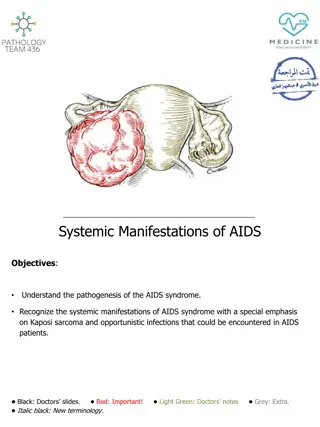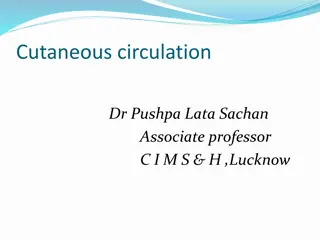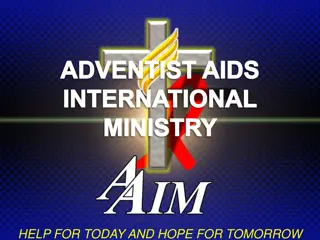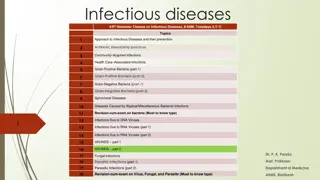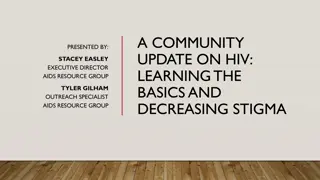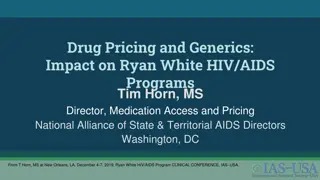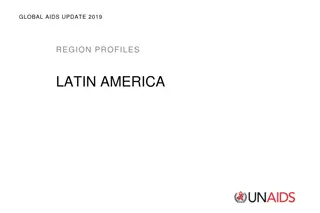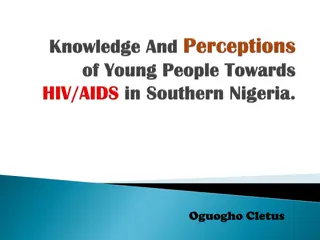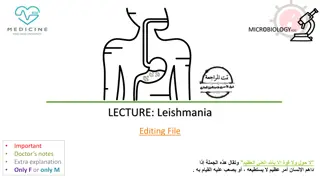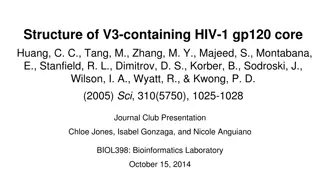Understanding Cutaneous Manifestations of HIV and AIDS
Human Immunodeficiency Virus (HIV) is a lentivirus that infects CD4 T lymphocytes, leading to Acquired Immunodeficiency Syndrome (AIDS). Cutaneous manifestations of HIV/AIDS vary depending on the stage of infection and CD4 T cell counts. Early signs include exanthem, oral hairy leukoplakia, candidiasis, psoriasis, seborrheic dermatitis, herpes zoster, and Kaposi sarcoma. Late-stage manifestations are often severe and may involve various infections, inflammatory conditions, and neoplastic diseases. Recognition of these dermatological signs can aid in early diagnosis and management of HIV/AIDS.
Download Presentation

Please find below an Image/Link to download the presentation.
The content on the website is provided AS IS for your information and personal use only. It may not be sold, licensed, or shared on other websites without obtaining consent from the author. Download presentation by click this link. If you encounter any issues during the download, it is possible that the publisher has removed the file from their server.
E N D
Presentation Transcript
CUTANEOUS MANIFESTATION OF AIDS DR .Anwar Issa Hasan 13/12/2018
HUMAN IMMUNODEFICIENCY VIRUS HIV: is lentivirus , member of retroviral family ,two type HIV1 &HIV2 . Its RNA ,with Reverse transcriptase enzyme . This virus infected human CD4 T lymphocytes ,by attachment to the specific cell surface (CCR5) receptors & use human cellular DNA for replication . Mode of transmission: sexually transmitted disease ,but also can transmitted by all body fluid of infected persons , contaminated needles in IV drugs users , vertical transmissions from mother to her baby . This virus cause AIDS ( acquired immunodeficiency syndrome). Actively treated with ART ( antiretroviral therapy). In HIV several cutaneous diseases ( disseminated coccidioidomycosis & Kaposi s sarcoma ) are AIDS defining conditions , whereas Seborrheic dermatitis & oral hairy leukoplakia can sever as clue for early diagnosis .
CUTANEOUS MANIFESTATION OF HIV INFECTION Its depending on : stage of viral infection , viral load & CD4 T lymphocytes accounts. Cutaneous manifestation are ; 1. Exanthem of primary HIV infection : occurs after incubation periods of 3-6 weeks Morbilliform eruption :appears in setting of peak viremia accompanied by orogenital ulceration , fever ,fatigue ,headache , pharyngitis , arthralgia , myalgia & GIT symptoms . Decrease in circulating CD4 lymphocytes. Rash last 4-5 days & constitutional symptoms last few days to few months. Dx :PCR to detects viral RNA in serum of patient & P24 antigen in plasma.
CUTANEOUS MANIFESTATION OF AIDS 2. Cutaneous manifestation of AIDS: number of cutaneous diseases that can point to HIV diagnosis ,usually sever , disseminated , may atypical presentations & reluctance to the treatments , including infections ,inflammatory diseases and neoplastic conditions . Types of cutaneous disease depend on CD4 T lymphocytes accounts so we divided its into 2 stages Manifestation of early stage ( CD4 T cell > 500 cell/mm3). Manifestation of late stage (CD4 cell <200 cell/ mm3).
MANIFESTATION OF EARLY STAGE 1. Acute retroviral syndrome. 2. Oral hairy leukoplakia : corrugated white plaques with hair like projections ,on the lateral aspect of tongue ,asymptomatic , caused by EBV infection. 3. Candidiasis: recurrent vaginal or oropharyngial candidiasis (oral thrush). 4. Psoriasis : new onset or exacerbation of preexisting psoriasis ,sever ,may resistant to treatments. 5. Seborrheic dermatitis : sever SD , involved face & scalp . 6. Herpes zoster : sever , multidermatomal , atypical ,may associated with systemic complications e.g. hepatitis ,encephalitis & pneumonia . 7. Kaposi sarcoma : disseminated ,typically involved mucosal membrane e.g. oral mucosa ,atypical with burse like lesions or large papules or ulcerative nodules or even verrocus ,may metastasis to GIT . 8. Eruptive atypical melanocytic nevi & melanoma.
MANIFESTATION OF EARLY STAGE Oral hairy leukoplakia Sever psoriasis in AIDS patient
MANIFESTATION OF LATE STAGE 1. Distributed on head & upper trunk , culture negative &biopsy show dermal infiltration with eosinophil. 2. Opportunistic infections : Cutaneous tuberculosis & other mycobacterial infections. Disseminated deep fungal infection e.g. Histopalsmosis ,cryptococcosis. Botryomycosis. Bacillary angiomatosis :due to grame negative bacilli called bartonella henselae & quintana. Eosinophilic folliculitis : itchy ,follicular papules with excoriation,
MANIFESTATION OF LATE STAGE Viral infections :herpes simplex virus ( Periorificial ,ulceration for one month duration), CMV perianal ulcer . Aspergillosis Giant molluscum : multiple large size papules ,involved face of adult person. 3. Acquired ichthyosis . 4. Major aphthosis(aphthous ulcers). 5. Non Hodgkin lymphoma . 6. Papular pruritic eruption. 7. Proximal white onychomycosis.: Dermatophytes infection of nail plate.
MANIFESTATION OF LATE STAGE Eosinophilic folliculitis Major aphtous ulcer
Opportunistic infections Giant molluscum HSV infection
CUTANEOUS MANIFESTATION OF AIDS 3. Immune reconstruction inflammatory syndrome : those disorders that can flare or worsen due to increase in ability to mount an inflammatory response following the institution of ART. INFECTIONS: viral ,bacterial ,Dermatophytes, mycobacterial & deep fungal . Inflammatory disorders : psoriasis ,eczema, AA, SD, sarcodosis & acne vulgaris. Neoplasms: Kaposi s sarcoma & non Hodgkin lymphoma .
DIAGNOSIS OF HIV INFECTION Diagnosis of HIV infection by serological detection of viral antigens or antibodies : 1. ELIZA: IgM or IgG . 2. Western blot test : IgG . 3. PCR : for viral RNA . 4. Viral culture . 5. Antigenic capture :for viral P24 OR gp 120 Ags.
ANTIRETROVIRAL THERAPY (ART) ART : usually include combination of two antiviral drug e.g. NRTI+nNRTI (typically tenofovir and Efavirenz), antiviral therapy classes are: 1. Nucleoside Reverse transcriptase inhibitors :Lamivudine & tenofovir. 2. nNRTI: Efavirenz. 3. Protease inhibitor: Indinavir. 4. CCR5 inhibitor : Maraviroc . 5. Fusion inhibitor :Enfuvirtide . 6. Integrase inhibitor :Raltegravir .





